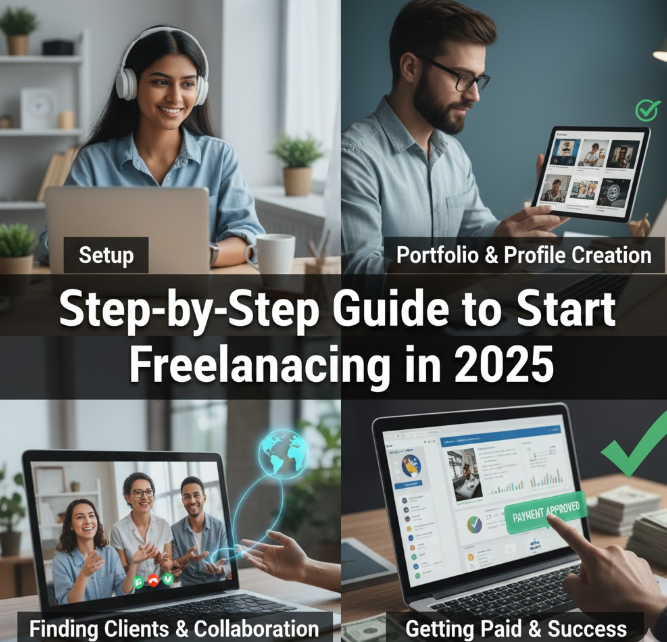The work world has been transformed over the last few years. Many others are opting to become their own boss, work from home and take control of their careers. Freelancing is the gateway to that freedom, and in 2025, the prospects were even more unpredictable. Whether you’re looking to make some extra money on the side or designing a full-time career, freelancing can make it happen.
This guide takes you through everything to get you started on your freelance journey. We’ll be covering all the basic steps from how to choose what services you’re going to offer, to getting your first clients through the door. You don’t need a college degree or years of experience to begin. All you need is stubbornness, a willingness to learn, along with a plan.
So, let’s look at how you can leverage your skills when starting a freelance business in 2025.
Why the Freelance Economy is Growing in 2025
Before we get to the how-to, why has freelancing taken off? Businesses worldwide are working with freelancers at record rates. They’re looking for flexible workers who can assist with certain initiatives without the financial commitment of full-time hires.
There has been considerable advancement in technology of working from home. In this day and age, with tools such as Zoom, Slack and project management software on hand, you can work even for clients that are at a different corner of the globe. You are able to communicate with a company halfway across the world from your living room.
The gig economy is thriving. Millions of people are now freelancing, studies suggest, and that number continues to grow. Writers, designers, programmers, marketers and countless others are needed by businesses. The demand is out there — you just have to access it.
Figure Out What Kind of Skills You Can Sell
The first thing you need to do on your freelancing journey is decide where your strengths fall. What can you do that other people will pay for? You may not believe you have any skills that are marketable, but don’t say I didn’t tell you so.
Think about your current job. What are you good at doing? Are you able to write emails, develop presentations, handle social media or organize data? These are all skills that business wants.
Consider your hobbies and interests. Would you like photography, graphic design, video editing or writing? Hobbies can be turned into paid freelance work.
This table illustrates a few in-demand freelance services in 2025:
| Service Category | Ideas | Required Skill Level |
|---|---|---|
| Writing & Content | Blog posts, copywriting, proofreading | Beginner – Advanced |
| Design & Creative | Logo design, social media graphics, illustrations | Intermediate – Advanced |
| Technology | Web development, app creation, software testing | Intermediate – Advanced |
| Marketing | Social media management, email campaigns, SEO | Beginner – Intermediate |
| Business Support | Virtual assistance, data entry, customer service | Beginner – Intermediate |
| Video & Audio | Video editing, podcast editing, voiceovers | Intermediate – Advanced |
No worries if you’re not already a pro. Plenty of freelancers have started from scratch and built their skills as they worked. The trick is to begin with what you have already and get better as you go.
Learn and Improve Your Skills
Once you’ve nailed down your service area, dedicate time to getting better at it. The more proficient you are, the more you can charge and the better clients you will gain.
Free resources are everywhere. On YouTube, there are thousands of tutorials for just about any skill you can think of. Sites like Coursera, Udemy or Skillshare offer inexpensive courses that can teach you professional-level skills.
Practice constantly. If you want to be a writer, write! If you want to make logos, design examples of fake company logos. Create a portfolio of work that demonstrates what you are capable of.
Keep abreast of industry and market trends. Technology and best practice evolve rapidly. Read industry blogs, participate in online communities, and gain insights from fellow freelancers in your niche.
Build the Foundation of Your Freelance Business
Now it’s time to get down and dirty with your business setup. You may work for yourself, but treat your freelancing like a business and you’re more likely to see success.
Choose a business name. This might be in the form of your own name (“Sarah Johnson Design” for example), or something more artistic that evokes what you do. Keep it simple and memorable.
Create professional email addresses. Free Gmail accounts are fine to get started but go for a professional format: yourname@gmail.com, not something like cooldude123@gmail.com.
Establish a basic bookkeeping system. You will need to have some numbers to help you understand your income and expenses for tax purposes. Wave (free) or via the additional features on QuickBooks (for a fee).
Educate yourself regarding the legalities in your area. Some areas need business licenses or permits. You may have to register as a sole proprietor, or form a business entity. For local requirements, check with government offices, or consult an accountant.
Build Your Online Presence
Five years from now, your online presence is like the front door of your store. People will look you up online when they are thinking about doing business with you, so it is very important to prove that you make your clients look good.
Create a portfolio website. This needn’t be a fancy or expensive meal. Platforms such as WordPress, Wix or Squarespace provide templates that can be customized. Your website should include:
- A brief summary of your services
- Work samples (your portfolio)
- Client reviews (as you receive them)
- Your contact information
- An about page that shares your story
Set up social media profiles. Instead, stick to platforms where your future clients spend time. Most freelancers can’t afford not to be on LinkedIn. Visual services can make use of Instagram. Writers and marketers can use Twitter.
Be sure to post routinely to demonstrate that you are active and participating. Share your work, industry advice and insight. This establishes more trust and can help clients find you.
Participate in online communities of people doing similar work as you. Reddit, Facebook groups and niche-specific forums are a great place to network, learn, and eventually find clients.

Decide on Your Pricing
Pricing your services can be kind of tricky, especially when you’re getting started. Charge too high, and you could scare off clients. Charge too little and you won’t make enough money.
See what other freelancers are pricing similar gigs at. Browse freelance sites, put out a query in online communities on social media and search your competitors’ websites.
Consider three pricing models:
Hourly Pricing: You bill by the hour. This is really good for a project that’s in progress, or a job where scope isn’t well-delineated. Beginners may charge $15-25 per hour while experienced freelancers can command $50-150+ per hour depending on their specialization.
Project-Based Pricing: You charge the same rate for the entirety of the project. As in $500 to write a website’s content or $1,000 for a logo and brand identity. This is often easier to do once you have spent enough time around projects to know how long they take.
Retainer Agreements: Clients pay a regular fee in exchange for an agreed amount of work or availability. It allows for consistent revenue, and it’s also great when you’ve proved yourself to your clients.
-
🕒 Want more productivity? Don’t miss 👉 Simple Ways To Manage Time As a Freelancer
For beginners, here’s a simple pricing guide:
| Level | Hourly Rate Range | Comments |
|---|---|---|
| Absolute Beginner | $10-20/hour | Need to build portfolio and get experience |
| Some Experience (6 months) | $20-35/hour | Few projects completed |
| Intermediate (1+ year) | $35-60/hour | Portfolio and testimonials built |
| Experienced (2+ years) | $60-100+/hour | Niche expertise, track record |
And remember, as you gain experience and a solid reputation, you can always raise your rates.
Find Your First Clients
This is where plenty of new freelancers become stuck. How do you attract people who will pay for your services? The good news is, there are so many ways to get clients in 2025.
Freelance Websites: Platforms such as Upwork, Fiverr, Freelancer and PeoplePerHour match freelancers with clients. Send a shout out campaign with detailed profiles of your skills and experience. These platforms can be a lot of work, but they are also where many clients explicitly seek help. Begin with competitive pricing to establish your reputation and feedback.
Your Network: Make sure everyone in your industry knows that you’re freelancing. Friends, family, old coworkers and acquaintances could use your services or know someone who could. Don’t be modest when promoting your new business.
Cold Outreach: Identify companies that might need your service and reach out to them. Send customized email outlining how you can help them. This takes some persistence, but can come up with great clients.
Social Media Marketing: Utilize your social media accounts to prove how much you know. Share valuable content, converse with potential clients and make it known that you are available to hire.
Job Boards: Monitor Indeed, LinkedIn Jobs, and niche job boards for freelance and contract work. Many businesses place freelance opportunities alongside their traditional jobs.
Content Marketing: Begin writing a blog or producing YouTube videos featuring advice on anything relevant to your industry. This will position you as an expert and organically pull clients in through search engines.
Create Winning Proposals
To apply for other opportunities you see through freelance platforms or promotional efforts, you’ll also submit proposals. Your offer to them is your best foot forward, so make it great.
Read the project description carefully. A lot of freelancers seem to produce boilerplate proposals that don’t fit the specific problem a client has. Demonstrate that you know what they’re after.
Start with a personalized greeting. Use the name of the client if you have it. Pick one thing about their project or business.
Tell them how you are going to solve their issue. Show them how your skills will help them meet their goals, not just list those skills.
Keep it concise. Busy customers will not read an essay. To the chase, quick and clear.
Include relevant work samples. If you’re applying for a blog writing job, link to blog posts you’ve written. Show them exactly what they’ll get.
Include an explicit call to action at the end. Give them some instructions to facilitate a call or have them message you. Make it simple for them to proceed.
Deliver Amazing Work
From the moment you get a client, your job is to impress them. Satisfied clients turn into repeat clients and referrals.
Communicate clearly and often. Inform them when you have received their project, ask upfront the questions necessary to clarify any uncertainty and keep them posted about your activity.
Meet your deadlines. If you tell someone you will have work to them by Friday, get that work to them on Friday. Better yet, deliver it Thursday. Dependability is one of the most important quality levels in a freelancer.
Go the extra mile. Throw them a little something extra they weren’t planning on. If you’re creating a logo, deliver it in an additional file format. If you are writing an article, make a few photo suggestions. These little touches pack big punches.
Ask for feedback. Ask the client what they think once you’ve delivered the project. If they are happy, ask if they’d be happy to give a testimonial. If they have questions, answer them with professionalism and speed.
Handle the Business Side
It’s not just about doing the work when you’re a freelancer — invoicing, contracts and finances have to be managed too.
Always use contracts. Simple contracts are better and even when the project’s small. A contract between you and your client will protect both parties. It should specify what you’ll provide, when you’ll provide it, how much you’ll get paid and payment terms. You also can get a template for one online, or pay a lawyer to draft one.
Send professional invoices. Include the name of your business, services rendered, balance due and how to submit payment. Invoicing is easily facilitated using tools like PayPal, Stripe, FreshBooks or Wave.
Track your time and expenses. Find out how long things take so you can price appropriately in the future. Save business expenses receipts – they are tax deductible.
Set aside money for taxes. Freelancers are responsible for their own taxes. A general guideline is to be saving approximately 25–30% of your income for taxes (this will differ depending on where you live). Hire an accountant particularly in the first year.
Manage Your Time Effectively
One of the most difficult aspects of freelancing is dealing with your own time. Working without a boss physically looking over your shoulder, it’s easy to get distracted or work too much.
Keep a schedule and follow through on it. Set the hours you’ll work and treat them like a conventional job. This helps maintain work-life balance.
Use productivity tools. Applications such as Trello, Asana or Notion can assist in organizing projects and tasks. Time-tracking tools, like Toggl, reveal where your hours go.
Set boundaries with clients. Just because you’re working from home doesn’t mean you are available 24/7. Set times when you read emails and respond to messages.
Take breaks. Working non-stop leads to burnout. Plan to have breaks at certain intervals every day and take a break each week.
Grow Your Freelance Business
Once you have a foothold and are working steady, think about that growth. How can you raise your rates and attract better clients?
Increase your rates. Raise your prices as you grow more experienced and have a stronger portfolio. Current happy clients are going to accept rate increases if you present them professionally.
Specialize in a niche. Generalists compete on price. Specialists compete on expertise. If you’re a writer, be the guy who tech companies call when they need blog posts. If you’re a designer then concentrate on restaurant branding. Niches enable you to charge more for what you do.
Build long-term client relationships. It’s simpler to keep existing customers than it is to find new ones. Deliver great service so clients return again and again.
Automate and streamline. Use templates for common tasks. Create systems for your workflow. The better you get, the more money you will make without working more hours.
Consider outsourcing. Once you are overwhelmed with work, you might employ other freelancers to help. You can then take on larger projects and earn more money.
Deal With Common Challenges
Freelancing isn’t always easy. Here’s how to troubleshoot common issues:
Downtime: There is not a single freelancer who has not had their share of dry spells. Establish an emergency fund during flush times. Utilize the downtime to sharpen your skills, brand yourself or focus on personal projects.
Clients From Hell: Some clients are difficult, vague or slow to pay up. Your contract protects you. If a client becomes too challenging, it is okay to professionally break up with them.
Imposter Syndrome: Many freelancers question their skills. Just keep in mind that you don’t have to know everything in order to offer value. Concentrate on doing well and keep learning.
Isolation: It can be a lonely business to work alone. Participate in coworking spaces, network at events or simply make video calls to other freelancers on a regular basis.
Scope Creep: When clients request more work than the original deal. Go back to that initial contract and politely reiterate, “extra asks are going to cost you more.”
The Independent Workers Toolbox 2025
Having the right tools can make freelancing easier and more professional. Here’s a look at some key tools for various needs:
Communication: Zoom (video calls), Slack (messaging), Gmail (email)
Project Management: Trello, Asana or Monday.com to see assignments, deadlines
Time Tracking: Use Toggl, Harvest or Clockify when you are billing by the hour
Invoicing: Wave (free), FreshBooks, or QuickBooks to make beautiful invoices with a professional look
Payment Gateway Integration: PayPal, Stripe or Wise (international payment)
File Sharing: If you have large files you want to send, Google Drive or Dropbox or sending over with WeTransfer
Design: Canva for basic graphics and Adobe Creative Cloud for professional design work
Writing: Grammarly to avoid errors, Google Docs for collaboration
Social Media: Buffer or Hootsuite for posting scheduling on multiple platforms
Many of these tools come with free versions or trials, which allows you to get started without large up-front expenses.
Stay Motivated and Focused
Freelancing requires self-discipline. You are accountable for your own success, which may be both empowering and daunting.
Set clear goals. Know what you want to accomplish each month, quarter and year. Put them on paper and look at them often.
Celebrate wins. Landed a great client? Finished a tough project? Remember to take a moment to give yourself credit, however modest it may be.
Connect with other freelancers. Participate in online forums or attend meetups. You motivate and help each other as you share with people who get it.
Keep learning. The freelance landscape changes constantly. Spend several hours a week acquiring new skills or getting better at others.
Remember your why. When you feel rough, remember why you wanted to freelance in the first place. Whether it’s freedom or flexibility, financial goals, whatever your “why” is — when you reconnect to it you’re able to push through the challenges.

Frequently Asked Questions
How much money do you need to freelance?
This is work you can start doing with little or no money. You require no more than a computer and an internet connection. Most freelancers start with an investment of under $100, using free tools and platforms. As you get paid, you can invest in better equipment and paid tools.
How long does it take to earn good money freelancing?
This varies greatly. Some people get their first paid project within days; others, it takes months. On average, you’ll spend 1-3 months getting your act together and finding your first few clients when starting a freelance business. Full time income is usually built within 6-12 months when you work hard consistently.
Is it necessary to have a college degree in order to freelance?
Not at all. Clients are interested in the results not the qualifications. Your past work, your skills, and your ability to do quality work mean a hell of a lot more than formal education. Plenty of successful freelancers never went to college or work in a field unrelated to their degree.
Can you freelance while working a full-time job?
Absolutely. There’s a lot of freelancers that start out part time, working night and weekends. This helps you launch your business and client base before quitting your job. Just make sure you’re permitted to work outside your job in your employment contract.
But what if I’ve got no experience or portfolio pieces?
Produce samples to demonstrate your expertise. Do free or discounted work for nonprofits or small businesses to build that portfolio. Write a few sample blog posts, design some practice logos or make up mock projects. Everyone starts somewhere.
How do I deal with taxes as a freelance worker?
Freelancers are independent contractors who file and pay their own taxes. Track all income and expenses. Set aside 25-30% for taxes. You might want to consult with an accountant, particularly in your first year. Some countries use separate tax regimes that benefit only self-employed persons.
If clients don’t pay on time, what do I do?
A few days after the due date, send kind payment reminders. If the payment has been lost for an extended period, follow up more strictly. The costs to be incurred due to late payment must be determined by a contract. In the event of continual non-payment, it may be necessary to use a collections firm or small claims court.
How many clients should I have?
Many factors influence this, including objectives and project scale. Some rely on one or more big consumers, while others deal with ten or more small consumers. Have enough backup customers to survive losing your prime income generator.
Is freelancing a profession that can help me raise a family?
In several circumstances, it has demonstrated viable. Generating multiple employment opportunities, retaining an urgent account, and continually promoting oneself were essential to sustaining it. Success takes time, but it is indeed achievable.
What’s the distinction between freelancing and having a second job?
There is some overlap, even though freelancing usually involves offering specialist services to clients on a per-project or contract basis. A side gig is something you do to earn more money outside of your major work, which may or may not include freelancing and is also inclusive of such activities as market selling and leasing properties.
Your Freelance Life Begins Today
It is simpler than ever to begin a freelance career in 2025. You have a wealth of amazing tools, platforms, and other resources at your disposal. Your talents are in great demand, and companies are on the lookout for excellent freelancers to assist them in achieving success.
However, bear in mind that every successful freelancer at some point was where you now are – making the first step, most likely feeling a little scared and hesitant.
Your freelancing adventure will not be the smoothest of rides. You’re going to encounter rejection, bad clients and days of doubt. But you’ll also enjoy the amazing freedom that comes from being your own boss, the joy of creating something yourself and the pleasure of turning what you know into an income.
Start today. Select your service, create profiles for it and get started with offering to your first potential client. Do something, no matter how imperfect. Every successful freelancer in the world will tell you this: the hardest part is getting started.
What you have to give is wanted in the freelance world. Your skills matter. Your work has value. And 2025 is the perfect moment to start this exciting journey. Take that first step and then simply keep learning, stay dedicated to growing, and witness how you grow the freelance career that’s just right for you.
I wish you the best of luck in your freelancing journey!




